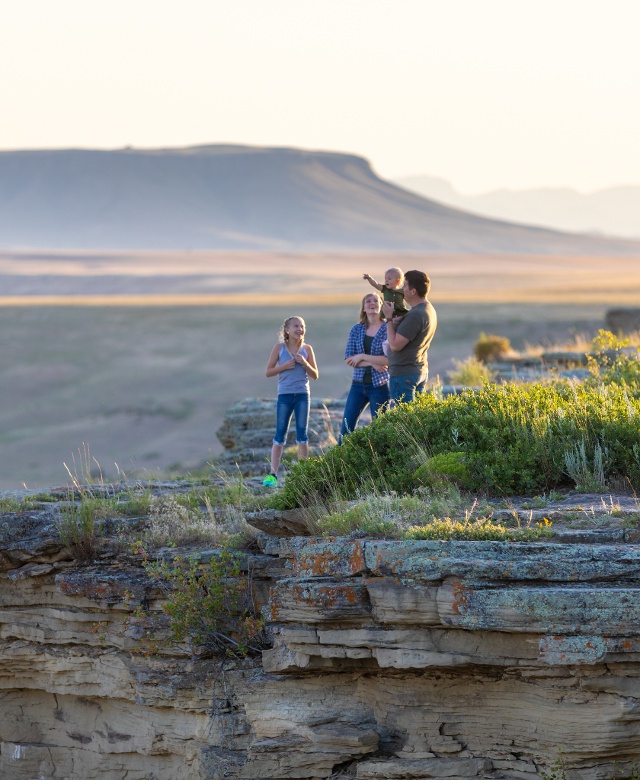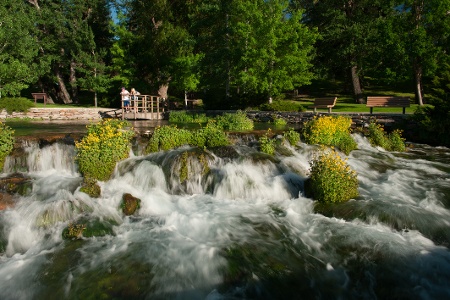
Heart of Montana Discoveries
Central Montana
Heart of Montana discoveries
Central Montana
Central Montana promises adventures both above ground and below. Straddling the line between the Rocky Mountain Front and the Central Plains, this culturally important region offers a compelling look into Montana's past, from ancient Native American buffalo jumps to Prohibition speakeasies.

GREAT FALLS' MOST DEFINING GEOGRAPHICAL FEATURE IS THE MIGHTY MISSOURI RIVER.
The falls themselves are now mostly submerged by hydroelectric dams, but their crashing energy was the impetus for the city's founding. In 1880, entrepreneur Paris Gibson imagined building "a new Minneapolis" on a boisterous river's banks. Start your visit at the Lewis and Clark National Historic Trail Interpretive Center, perched on a river bluff. Meriwether Lewis called this boulder-choked stretch "the grandest sight I ever beheld," but the center's two-story-high diorama tells of the explorers' arduous 18-mile-long portage. Expedition members had to winch their canoes and gear up and over precipitous cliffs and waterfalls.
Do your own Missouri River reconnaissance by rambling along the River's Edge Trail from the interpretive center. Less than a mile east is Giant Springs State Park where gushing water emerges from an underground aquifer at an astonishing 156 million gallons per day. Head downtown to tour the C.M. Russell Museum, which holds the world's largest collection of Russel's paintings, artifacts and bronze sculptures-bucking horses, buffalo hunts, and tribes-plus the belongings and letters of "America's Cowboy Artist." Don't miss the American bison exhibit with more than 1,000 Northern Plains Indian artifacts. Clothing, tools, regalia and art reveal Native Americans' reliance on the bison.
Fuel up on calories In town before exploring farther afield. At the log-house Roadhouse Diner, feast on celebrity-grade diner chow, like Montana-grown beef or black bean burgers on scratch-made buns. The Celtic Cowboy Pub dishes up hearty shepherd's pie and Irish fare In an 1890s livery stable, Great Falls' oldest commercial building.
Fifteen miles west of Great Falls, visit the archaeological site at First Peoples Buffalo Jump State Park. More than a thousand years before Lewis and Clark, prehistoric Native Americans drove herds of bison off a mile-long, 30-foot-high bluff, then slaughtered the animals for hides and food. Tour the fascinating interpretive center or take a guided hike to see ancient teepee rings, petroglyphs and pictographs.

WATERWAYS
From Great Falls, cruise south to White Sulpher Springs along U.S. 89, known as the Kings Hill scenic Byway, as it traverses Helena-Lewis and Clark National Forest and the Little Belt Mountains. This area Is rich with options for adventurers: hiking, biking. fishing and floating. In White Sulpher Springs, tour the Hilltop Castle Museum and Carriage House, an 1892 stone mansion built by rancher Byron Roger Sherman. The Spa Hot Springs Motel doles out liquid nirvana - three hot springs pools of varying temperatures.
If you're hungry, make a pit stop at Bar 47 for modern riffs on comfort food - sea salt caramel fries, "adult" milkshakes, fried green beans and pulled pork mac 'n' cheese. Then hop back in the car and swing southwest to Butte. Unlike most rough-and-tumble mining towns in Montana, Butte's underground riches never went completely bust. The city lies on top of what was called The Richest Hill on Earth, an unparalleled bounty of mineral deposits, especially silver and copper. See the wealth that Butte created at the 1888 Copper King Mansion, a 34- room Victorian brick palace graced by frescoed ceilings and Tiffany stained-glass windows. Its owner was one of the world's richest men. Butte's mining heritage lives on at Montana Tech, a college specializing in mineral science, and at the World Museum of Mining, where you can don a hard hat and headlamp and descend 100 feet underground to peek Inside the Orphan Girl Mine and learn about minors' lives.
Go underground a second time at the Rookwood Speakeasy Museum, below a Main Street sidewalk. The spot dates to Prohibition, when hooch was Illegal but not terribly hard to obtain. Hidden behind secret doors in the Rookwood Hotel's basement, this scofflaw watering hole was one of Butte's estimated 150 Prohibition-era speakeasies. See its elaborately carved mahogany bar and poker table covered with chips on a tour with Old Butte Historical Adventures.
For bites in Butte, steak-lovers head to Casagranda's Steakhouse for Rocky Mountain beef cut by hand. Longtime favorite Gamer's Cafe serves unpretentious chili and local gossip. Butte native and motorcycle daredevil Evel Knievel frequented the Freeway Tavern for its pork chop sandwich, a nod to the Cornish miners who once populated this town. ln uptown Butte, Park 217 caters to discriminating palates at Its below-street-level wine bar and bistro.

RICH HISTORY
An hour northeast of Butte lies Helena, Montana's capital. Helena's founding happened with a gold strike-followed by a silver strike, then a lead strike-but it also became an important trade center. Merchants struck it rich, and to prove it, they built mansions. One is now The Sanders, a luxurious painted-lady bed-and-breakfast with elegant period furnishings and ornate woodwork.
See more of the city's architectural legacy by riding the Last Chance Tour Train an open-air wheeled trolley that meanders past the Cathedral of St Helena's ornate 230-foot-tall spires and the elegant Montana State Capitol Building.Tour the copper-domed structure to see C.M. Russell's mural Lewis and Clark Meeting Indians at Ross' Hole and more Iconic Montana art.
Just outside Helena is one of Missouri River's most remarkable canyons, bounded by 1,200-foot limestone cliffs and guarded by bighorn sheep and mountain goats. Lewis and Clark named this river stretch Gates of the Mountains. Don't leave Helena without taking a two-hour boat tour to see it and learn the origin of the name.

EXTEND YOUR STAY
Drive north from Helena to Choteau to see the Old Trail Museum, or book with Choteau-based Dropstone Outfitting for guided day hikes and stock-supported multiday trips In the Bob Marshall Wilderness.
